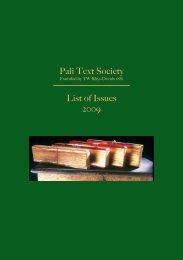A SYNOPSIS OF THE RESEARCH PROJECT ... - Pali Text Society
A SYNOPSIS OF THE RESEARCH PROJECT ... - Pali Text Society
A SYNOPSIS OF THE RESEARCH PROJECT ... - Pali Text Society
- No tags were found...
Create successful ePaper yourself
Turn your PDF publications into a flip-book with our unique Google optimized e-Paper software.
In my research, I will be providing an elaborated introduction and an annotated translation tothe commentarial exposition of these Suttas.Significance and the background to the studyThe scholars, who have previously studied the Pāli Canon, and translated the discourses paidlittle attention to its commentaries and sub commentaries. In the available translations ofcommentaries a large section of the valuable teachings of the Buddha have not been givenadequate attention. Furthermore, there appear to be certain misinterpretation of passages.Difficult words and abstruse points of the discourses that occur in the Pāli Canon cannot besufficiently supported without due reference to their Pāli commentaries. Pāli commentariespreserve the earliest interpretation of the texts. Though Pāli commentaries were properlydocumented in the 5th century A.D., the interpretation and exposition of the texts are basedon a much earlier tradition of interpretation that was common to Theravāda School. As suchthe available interpretation belongs to a quite close period of the original texts of the Suttas.Therefore, Pāli commentaries provide a source to make them understand how the earlyscholars had interpreted the texts of the Pāli canon.It seems Pāli commentaries, expositions and their interpretations provide a background to thecontext and the cultural side of the discourses. The words and terms often get their meaningsin the relevant cultural context. In comprehending a Sutta, knowledge of its context andcultural background is vital to grasp the meaning and relationship of the discourses. Pālicommentaries have been able to interpret the Suttas in their natural contexts and provide abackground to the students who follow the Pāli canon.2
The knowledge I aim to harness from the thesis, is expected to generate a wide perspective ofthe modern reading of the Pāli canon in the selected middle length discourse.The outcome of the thesis is expected to lift the barriers that inhibit comprehensiveunderstanding of the discourses, and make available translations to facilitate the reading ofthe discourses alongside their commentaries.Scope and Methodology of ResearchThe main objective of my study is to present a comprehensive translation of Ōpamma Vaggaof Papañca Sūdanī. Since there has been no previous English translation of the commentarialexposition of Ōpamma Vagga, I will be providing an English translation of this section of themiddle length discoursesThe translation would be complemented by annotations. Whenever necessary, grammaticalexplanations would be given with detailed meaning as originally intended by thecommentator. In addition, without due references to sub commentaries, a reader may not beable to achieve a proper understanding of passages in the original text. So, I shall refer torelevant passages of the aforesaid sub-commentaries wherever necessary.The texts which shall be used for this translation is taken partially from the edition of the Pāli<strong>Text</strong> <strong>Society</strong>, London, with a few changes based on the Sinhalese editions. For this purpose,the relevant portions of the two editions of MN would be consulted in order to determine themost appropriate readings.In my general introduction, I propose to discuss the importance of the original text as acommentary on the Sutta Pitaka.3









